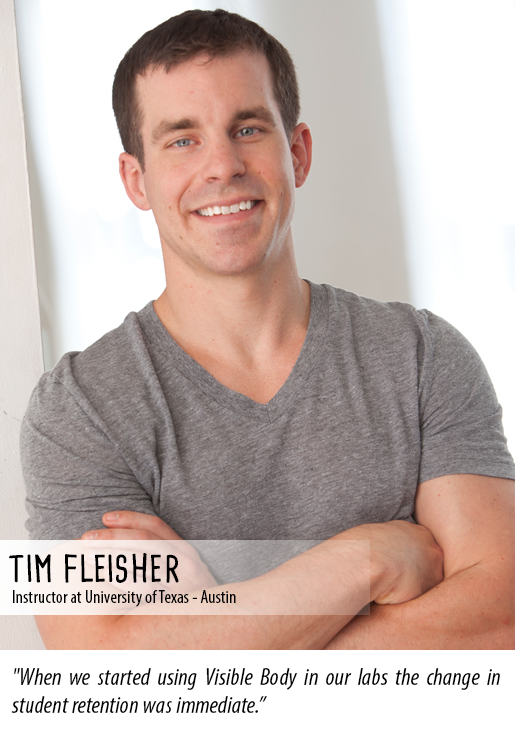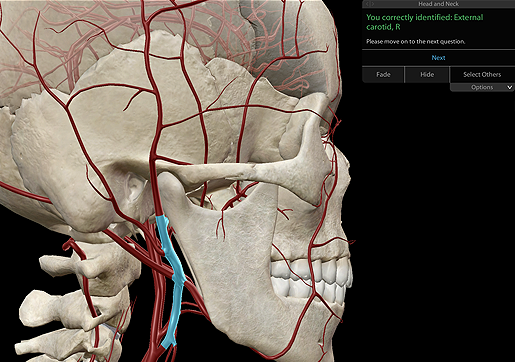Posted on 2/15/18 by Maite Suarez-Rivas
Tim Fleisher is an Assistant Instructor at the University of Texas - Austin and has been using Visible Body apps in his lab course for the past few semesters. We caught up with him to ask how using Human Anatomy Atlas has changed his anatomy lab course.
This is my third year teaching the lab part of BIO 446. It’s a one-semester combined lecture and lab course for upper-division undergraduate students pursuing a biology or health career. The majority of health career majors in the course are biology students aspiring to be doctors, nurses, physical therapists, occupational therapists, and physician assistants.
When I first taught the lab we used a computer for online searches and virtual microscopy. Students have a lab manual that they are required to fill out using two textbooks, various online resources, and anatomical models we have in the lab. We also use playdough, clay, and pipe cleaners to build various anatomical structures.
Those tools helped us to define various anatomical terms and provided graphics for the students to see how anatomy was positioned. By building anatomical structures and examining anatomical models, students were able to interact with the anatomy and examine how it was positioned within the body.

While these models and playdough labs were great, we needed a more dynamic platform so that students could grasp the concepts and definitions within a book while examining the anatomy. Going back and forth between a book and a model became tedious and limited the amount of material covered during lab time. The models were also very expensive, took up a lot of space, and were often not as detailed as we would have liked. Some showed one detailed structure; if the models had various structures, they were not detailed enough for what we were looking for and didn’t have related systems, like the skeleton.
When we started using Visible Body in our lab the change in student retention was immediate. We are now able to integrate more information and utilize new lab activities in a more functional and integrative manner. For example, Human Anatomy Atlas made the eye lab very easy to teach. When looking at the eye, it’s great how in Atlas you can rotate the model and see the optic nerve with the oculomotor nerve. Students can see why the histology looks the way it does on the slide (longitudinal cut of the optic/cross sectional of the oculomotor). It was perfect! Students are able to walk away from our class with a very thorough and functional understanding of human anatomy.
When we first used Visible Body apps, students loved them but we didn’t have a solid plan. All I could think was, "it will be great to have something to help visualize the anatomy in 3D." I soon realized that while the students were able to do this, they were not using the platform to its full potential. The best piece of advice I have for instructors interested in integrating 3D anatomy apps into a lab course is to make a plan that relies on the students using the Visible Body app to complete the work. Change and modify your class content using VB. Then you will see students really learn more.
We have students work through quizzes. We also have group work, such as case studies and games, that rely on 3D model views in Visible Body. It was a success when we simply offered VB as an additional study tool, but using VB to accomplish learning objectives via specific activities is best. Using the texts during lab was holding us back. Now students can interact with the anatomy, learn various systems, and read short descriptions about the crucial anatomical information.
 Image from Human Anatomy Atlas.
Image from Human Anatomy Atlas.
I teach anatomy to lots of different groups. During summer and winter breaks from the University of Texas, I teach short courses to Pilates instructors and physical therapists. In those courses, I’ve used augmented reality and Visible Body on the iPad for demonstrations. When you have such a small amount of time (for example, a 2-hour course on thoracic spine pathology), Visible Body makes a huge difference in student experience and retention.
Be sure to subscribe to the Visible Body Blog for more anatomy awesomeness!
Are you an instructor? We have award-winning 3D products and resources for your anatomy and physiology course! Learn more here.
When you select "Subscribe" you will start receiving our email newsletter. Use the links at the bottom of any email to manage the type of emails you receive or to unsubscribe. See our privacy policy for additional details.
©2026 Visible Body, a division of Cengage Learning